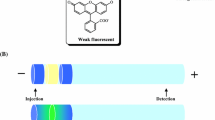Abstract
We have developed two methods for the quantitation of gabapentin in human plasma. They are based on capillary electrophoresis with laser-induced fluorescence detection (CE-LIF) with and without solid-phase extraction (SPE) and the derivatizing reagent 5-(4,6-dichlorotriazinyl)amino fluoresencin. The conditions for derivatization, separation and extraction were investigated in detail, and the optimal labeling conditions include a temperature of 40 °C, a reaction time of 30 min, and the use of a borate buffer of pH 9.0 as the reaction medium. A borate buffer of pH 9.2 served as a background electrolyte for CE separations. The CE-LIF and SPE-CE-LIF methods have linear ranges of 5–200 nmol L−1 and 0.2–10 nmol L−1, respectively, and the limits of detection are 0.5 and 0.02 nmol L−1, respectively. The SPE-CE-LIF method was successfully applied to the determination of gabapentin in blood plasma samples.

Two methods have been developed for the quantization of gabapentin (GBP) in human plasma. They are based on capillary electrophoresis-laser induced fluorescence detection (CE-LIF) with and without solid-phase extraction (SPE) and the derivatizing reagent 5-(4,6-dichlorotriazinyl)aminofluorescein.





Similar content being viewed by others
References
Tallian KB, Nahata MC, Lo W, Tsao CY (2004) Pharmacokinetics of gabapentin in paediatric patients with uncontrolled seizures. J Clin Pharm Ther 29:511–515
Ouellet D, Bockbrader HN, Wesche DL, Shapiro DY, Garofalo E (2001) Population pharmacokinetics of gabapentin in infants and children. Epilepsy Res 47:229–241
Taylor CP, Angelotti T, Fauman E (2007) Pharmacology and mechanism of action of pregabalin: The calcium channel α2-δ (alpha2-delta) subunit as a target for antiepileptic drug discovery. Epilepsy Res 73:137–150
Siddiqui FA, Arayne MS, Sultana N (2010) Spectrophotometric determination of gabapentin in pharmaceutical formulations using ninhydrin and pi-acceptors. Eur J Med Chem 45:2761–2767
Ulu ST, Kel E (2011) Sensitive spectrofluorimetric method of analysis for gabapentin in pure and pharmaceutical preparations. Chin J Chem 29:562–566
Borrey DCR, Godderis KO, Engelrelst VIL, Bernard DR, Langlois MR (2005) Quantitative determination of vigabatrin and gabapentin in human serum by gas chromatography-mass spectrometry. Clin Chim Acta 354:147–151
Ebrahimzadeh H, Yamini Y, Firozjaei HA, Kamarei F, Tavassoli N, Rouini MR (2010) Hollow fiber-based liquid phase microextraction combined with high-performance liquid chromatography for the analysis of gabapentin in biological samples. Anal Chim Acta 665:221–226
Cao LW, Hu Y, Meng JX (2010) Sensitive determination of gabapentin in human urine by high-performance liquid chromatography with UV–Vis and fluorescent detection. J Liq Chromatogr R T 33:1487–1501
Harahap Y, Sinandang T, Rahmawati R (2007) Analysis of gabapentin in human plasma in vitro by high performance liquid chromatography-fluorescence. Drug Future 32:131–131
Cai YL, Yang JJ, Wang YF (2010) Determination of gabapentin using capillary electrophoresis with laser-induced fluorescence detection. Chin J Chromatogr 28:1179–1184
Lin FM, Kou HS, Wu SM (2004) Capillary electrophoresis analysis of gabapentin and vigabatrin in pharmaceutical preparations as ofloxacin derivatives. Anal Chim Acta 523:9–14
Chang SY, Wang FY (2004) Determination of gabapentin in human plasma by capillary electrophoresis with laser-induced fluorescence detection and acetonitrile stacking technique. J Chromatogr B 799:265–270
Souri E, Jalalizadeh H, Shafiee A (2007) Optimization of an HPLC method for determination of gabapentin in dosage forms through derivatization with 1-fluoro-2,4-dinitrobenzene. Chem Pharm Bull 55:1427–1430
Borrey DCR, Godderis KO, Engelrelst VIL (2005) Quantitative determination of vigabatrin and gabapentin in human serum by gas chromatography-mass spectrometry. Clin Chim Acta 354:147–151
Poinsot V, Carpene MA, Bouajila J (2012) Recent advances in amino acid analysis by capillary electrophoresis. Electrophoresis 33:14–35
Ramautar R, de Jong GJ, Somsen GW (2011) Developments in coupled solid-phase extraction-capillary electrophoresis 2009-2011. Electrophoresis 33:243–250
Vermeij TAC, Edelbroek PM (2004) Simultaneous high-performance liquid chromatographic analysis of pregabalin, gabapentin and vigabatrin in human serum by precolumn derivatization with o-phtaldialdehyde and fluorescence detection. J Chromatogr B 810:297–303
Mohsen A, Mohammad-Reza R, Alireza AP, Abbas S (2010) A new pre-column derivatization method for determination of gabapentin in human serum by hplc using UV detection. J Chromatogr Sci 48:358–361
Sevgi TU, Elif K (2011) Highly sensitive determination and validation of gabapentin in pharmaceutical preparations by hplc with 4-fluoro-7-nitrobenzofurazan derivatization and fluorescence detection. J Chromatogr Sci 49:417–421
Rada P, Tucci S, Pérez J, Teneud L, Chuecos S, Hernández L (1998) In vivo monitoring of gabapentin in rats: a microdialysis study coupled to capillary electrophoresis and laser-induced fluorescence detection. Electrophoresis 19:2976–2980
Cao LW, Zhang HS, Wang H (2007) Analysis of amino acid neurotransmitters by capillary electrophoresis and laser-induced fluorescence using a new fluorescein-derived label. Microchim Acta 158:361–368
Wang SM, Fan L, Zhou WL (2011) Sensitive analysis of 5-(4,6-dichloro-s-triazin-2-ylamino) fluorescein-labeled catecholamines by mixed MEKC–LIF. Chromatographia 72:1121–1128
Liu X, Hu YQ, Ma L, Lu YT (2004) Determination of phosphoamino acids derivatized with 5-(4,6-dichloro-s-triazin-2-ylamino) fluorescein by micellar electrokinetic chromatography. J Chromatogr A 1049:237–242
Molina M, Silva M (2002) Analytical potential of fluorescein analogues for ultrasensitive determinations of phosphoruscontaining amino acid herbicides by micellar electrokinetic chromatography with laser-induced fluorescence detection. Electrophoresis 23:1096–1103
Acknowledgement
This work was supported by “the fundamental research funds for the central universities” (NO. 11609702).
Author information
Authors and Affiliations
Corresponding author
Rights and permissions
About this article
Cite this article
Cao, L., Liang, S., Tan, X. et al. Determination of gabapentin in human plasma by capillary electrophoresis-laser induced fluorescence detection with and without solid-phase extraction. Microchim Acta 178, 285–292 (2012). https://doi.org/10.1007/s00604-012-0835-0
Received:
Accepted:
Published:
Issue Date:
DOI: https://doi.org/10.1007/s00604-012-0835-0




